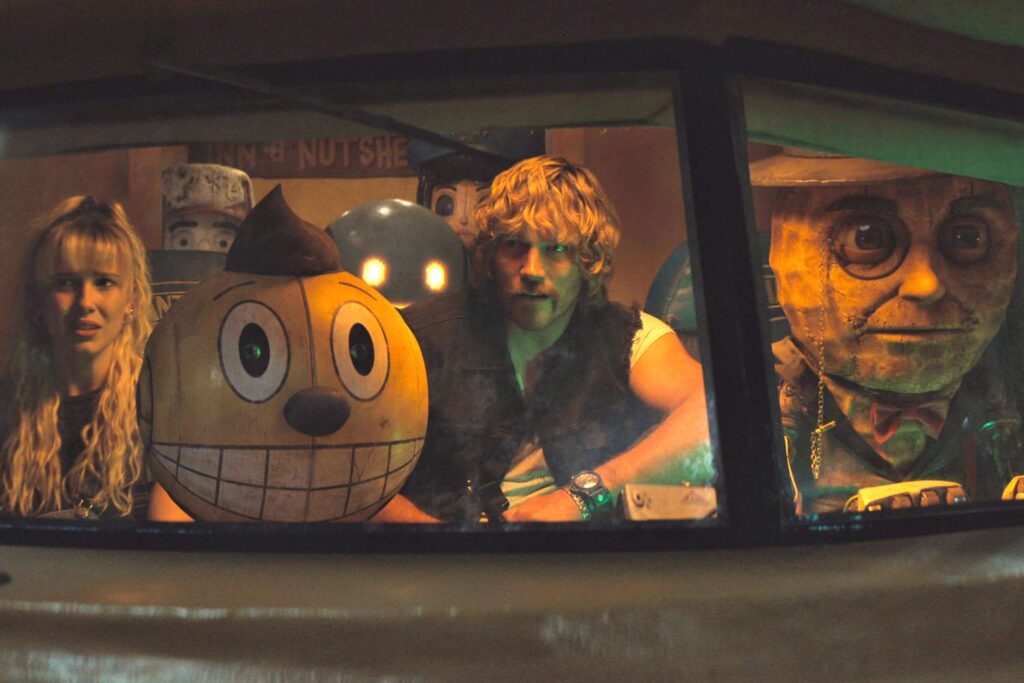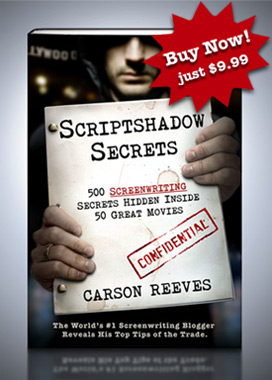Genre: Sci-Fi/Action
Premise: In a [sort of] post-apocalyptic world, a young woman teams up with a truck driver to traverse through a robot wasteland to retrieve her brother, who has been taken by an evil CEO and used as the brains of his internet company.
About: This was the 320 million dollar big swing from the Russo Brothers for Netflix and they brought back their Avengers screenwriters, Christopher Markus and Stephen McFeely, to help them write it. The movie is based on the iconic sci-fi art of Simon Stålenhag and stars Netflix superstar, Millie Bobby Brown, and worldwide superstar, Chris Pratt.
Writers: Christopher Markus & Stephen McFeely
Details: 2 hours long

I’m going to be straight up with you. This review’s going to get ugly. So, before it does, let me cast some compliments on The Electric State. Hollywood is obsessed with IP to the point of making a generation of moviegoers bored out of their minds.
Kids these days – at least the ones I know – don’t watch movies. And why would they? Studio films don’t have any soul left in them and I suspect they don’t have many people making them who actually love movies. They’re just doing a job. And when everybody is just “doing a job,” you get really bland product.
So I respect the Russo Brothers for, at least, trying something new. This is tricky material here. It’s a weird world with weird rules and a hard-to-wrestle-down mythology. I love that they’re trying to explore uncharted territory.
But there’s the irony.
Within that exploration, they went back and based almost all of their choices on the very IP they’re running away from. So the most original big budget movie of the year feels like the most cliched.
I still want Hollywood making weird sci-fi movies. But they have to bring in the kind of talent who can guide those movies to strong places. I used to think the Russo Brothers were that talent. But I’m not sure anymore.
It’s the 90s. Errr….. sort of. Because in these 90s, there was a robot uprising. Except I lived through the 90s and I don’t remember any robot uprisings. So I’m not sure what “period” we’re setting this movie in. Anyway…
A young woman named Michelle lost her younger brother in this robot war. But several years later, the government has squashed the rebellion and now keeps all robots inside designated fenced-off areas.
One night, a robot appears in Michelle’s backyard, just like E.T. (and I mean *just* like E.T. – as in they steal the exact same shot from that movie) and the robot claims to be Michelle’s dead brother. Well, sort of. You see, for reasons that are never made clear, the robot can’t speak normally. He can only speak in pre-programmed soundbites. Every other robot can speak normally. But not this one. Kind of convenient since, if he could speak normally, he’d be able to tell Michelle where his real-life body was and that would’ve cut 90 minutes out of the movie.
Anyway, Michelle pairs up with the robot to travel across the country to find her brother. Along the way, she’s forced to utilize the help of a truck driver named Keats. Keats is a rebel in that he often teams up with robots, even though robots are bad! So he and Michelle go into the Restricted Zone, despite it being littered with violent robots and, what do you know, win them over.
An entire team of robots then joins the duo in attacking Sentre, the big bad internet company that is holding her brother and is also the primary entity keeping the robots down. Michelle wants her brother back and the robots want their life back. Final battle. The end.
This is a great time to remind everyone that writing screenplays is a series of creative choices. One of the reasons it’s so difficult is that if you make the wrong creative choice regarding a couple of the key pillars in the story, there’s no way to save the script. You’re done.
For example, if you create a really unlikable main character, that creative choice is going to be in our face every single scene.
The problem with The Electric State is that it gets nearly all of the key creative choices wrong, starting with the setting. It doesn’t make sense to create a period piece about a time that never happened. I’ve never seen a successful movie that’s done this and I have no idea why anyone would think it’s a good idea. Because what you’re doing is you’re saying, “Nothing matters because none of this really happened.” If you would’ve, simply, set this 5 years in the future, it would’ve solved so many problems with the script.

The next creative choice The Electric State screwed up was the tone. If there’s one good lesson that came out of the superhero era, it’s that you don’t betray the source material. The further you stray from it, the worse the movie usually gets. So, by turning Stålenhag’s dark art into a plucky fun action-adventure movie, the movie never stood a chance. That wasn’t the story that Stålenhag intended to tell. And you can see that in every frame of the movie, which is fighting itself, trying to turn a cat into a dog.
Next up, the amount of borrowing in this movie is next-level embarrassing. From E.T. to Transformers to Guardians of the Galaxy to The Phantom Menace. It’s one movie after another where you recognize a character or a plot beat.
If you’re writing something and you’re constantly saying to yourself, “Yeah, it’ll be just like [that great movie]” and “Ooh, this character will be like that character from [that great movie.],” that’s BAD. Cause people are going to see those things and think of those movies, which are better by the way, than your movie. And the more you do that, the less your movie becomes your movie anyway. Instead, it becomes a pastiche of movies.
You get one clean rip off another famous movie and that’s it. But even then, you have to be careful. For example, you can’t base your hero off of John McClane in a terrorist action-thriller. The setup is too similar to Die Hard. But if you made a sci-fi movie about a cop on another planet, *that* character you can base on John McClane, because it’s a different genre and different setting.
What you don’t want to do is what Electric State did, which was make a sci-fi movie that borrowed from a bunch of other sci-fi movies.
On top of that, there was a whole lot of stuff in this script that didn’t make sense. Why couldn’t the E.T. robot – the one who says it’s got Michelle’s brother inside of it, speak when every other robot spoke?
How are we on a post-apocalyptic journey when the world is fine? Everything is running smoothly. Yet the movie is treating the journey like it’s happening in the “Quiet Place” universe.
And the movie didn’t even get the BASIC stuff right. The most basic thing you need out of a movie like this is to create an interesting unresolved dynamic between the two characters who are around each other the most – in this case, Michelle and Keats.

Yet I couldn’t tell you the first thing about their relationship. They have so little to actually discuss that they could’ve existed on their own separate journeys and nothing would’ve changed.
You have to build a compelling storyline into any character combination that has a lot of screen time together. There wasn’t a single issue between Michelle and Keats other than they occasionally annoyed each other. Compare that to Deadpool and Wolverine, who seemed to have generations of beef with each other that they had to bury in order to work together. That’s how you create a compelling unresolved relationship.
What happened to the Russo Brothers, by the way? I started to wonder if they were always this bad. But that Captain America sequel they directed was awesome. That was a great movie with great set pieces. And the two Avengers movies were good too.
But since then, they made The Gray Man, Cherry, and Citadel. And now this, their worst movie of all.
So, if this silly version of the story was so bad, what should they have done to fix it? Well, there was this sci-fi book published in 1972 called Roadside Picnic about how time stops and then when it starts again, humanity realizes that aliens came here and lived here for a long time before finally leaving. They’ve since left all these remnants and the book follows people who go looking for those remnants.
Just like Stålenhag’s work, it’s dark post-apocalyptic stuff and fits the same vibe as his drawings. I know the budget would’ve had to have been lower. But I’m positive the movie would’ve been better. Because even with 320 million, the Russos didn’t create one memorable set piece. Not one! In a big sci-fi action movie! That’s crazy. At least with the darker version, you could’ve explored better characters and thematic elements that connected with people. This was just silly garbage.
How bad are we talking here? Here’s how bad. If you told me you had Netflix and you wanted to know which movie you should watch tonight, The Electric State or that Meghan Fox is a robot Hand that Rocks the Cradle ripoff, I would tell you that you would have an infinitely more entertaining time watching the Meghan Fox movie.
[x] What the hell did I just watch?
[ ] wasn’t for me
[ ] worth the stream
[ ] impressive
[ ] genius
What I learned: Use previous great movies as inspiration. But don’t steal actual elements from them. For example, if you have a time machine in your script, don’t make it a car, cause people are going to think of Back to the Future. Be inspired by the broad strokes, never the key individual elements.

